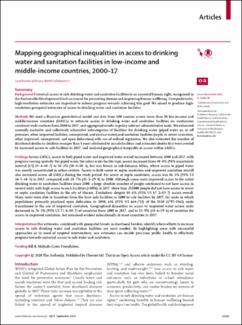Mapping geographical inequalities in access to drinking water and sanitation facilities in low-income and middle-income countries, 2000–17
Fecha
2020-09Autor
Deshpande, Aniruddha
Miller-Petrie, Molly K
Lindstedt, Paulina A
Baumann, Mathew M
Johnson, Kimberly B
Blacker, Brigette F
Abbastabar, Hedayat
Abd-Allah, Foad
Abdelalim, Ahmed
Abdollahpour, Ibrahim
Abegaz, Kedir Hussein
Abejie, Ayenew Negesse
Abreu, Lucas Guimarães
Abrigo, Michael RM
Abualhasan, Ahmed
Kokou Accrombessi, Manfred Mario
Adamu, Abdu A
Adebayo, Oladimeji M
Adedeji, saac Akinkunmi
Adedoyin, Rufus Adesoji
Adekanmbi, Victor
Adetokunboh, Olatunji O
Adhikari, Tara Ballav
Afarideh, Mohsen
Agudelo-Botero, Marcela
Ahmadi, Mehdi
Ahmadi, Keivan
Ahmed, Muktar Beshir
Ahmed, Anwar E
Akalu, Temesgen Yihunie
Akanda, Ali S
Alahdab, Fares
Al-Aly, Ziyad
Alam, Samiah
Alam, Noore
Alamene, Genet Melak
Alanzi, Turki M
Albright, James
Albujeer, Ammar
Alcalde-Rabanal, Jacqueline Elizabeth
Alebel, Animut
Alemu, Zewdie Aderaw
Ali, Muhammad
Alijanzadeh, Mehran
Alipourv, Vahid
Aljunid, Syed Mohamed
Almasi, Ali
Almasi-Hashiani, Amir
Al-Mekhlafi, Hesham M
Altirkawi, Khalid A
Alvis-Guzman, Nelson
Alvis-Zakzuk, Nelson J
Amini, Saeed
Maever Amit, Arianna L
Herrera Amul, Gianna Gayle
Andrei, Catalina Liliana
Anjomshoa, Mina
Ansariadi, Ansariadi
Abelardo Antonio, Carl T
Antony, Benny
Antriyandarti, Ernoiz
Arabloo, Jalal
Amin Aref, Hany Mohamed
Aremu, Olatunde
Armoon, Bahram
Arora, Amit
Aryal, Krishna K
Arzani, Afsaneh
Asadi-Aliabadi, Mehran
Asmelash, Daniel
Tasew Atalay, Hagos
Masoume Athari, Seyyede
Shamsadin Athari, Seyyed
Atre, Sachin R
Ausloos, Marcel
Awasthi, Shally
Awoke, Nefsu
Ayala Quintanilla, Beatriz Paulina
Ayano, Getinet
Amogre Ayanore, Martin
Asmare Aynalem, Yared
Azari, Samad
Azman, Andrew S
Babaee, Ebrahim
Badawi, Alaa
Bagherzadeh, Mojtaba
Bakkannavar, Shankar M
Balakrishnan, Senthilkumar
Banach, Maciej
Mattar Banoub, Joseph Adel
Barac, Aleksandra
Barboza, Miguel A
Winfried Bärnighausen, Till
Basu, Sanjay
Bay, Vo Dinh
Bayati, Mohsen
Bedi, Neeraj
Beheshti, Mahya
Behzadifar, Meysam
Behzadifar, Masoud
Fernanda, Diana
Ramirez, Bejarano
Bell, Michelle L
Bennett, Derrick A
Benzian, Habib
Ajema Berbada, Dessalegn
Bernstein, Robert S
Ganapati Bhat, Anusha
Bhattacharyya, Krittika
Bhaumik, Soumyadeep
Bhutta, Zulfiqar A
Bijani, Ali
Bikbov, Boris
Bin Sayeed, Muhammad Shahdaat
Kishore Biswas, Raaj
Bohlouli, Somayeh
Boufous, Soufiane
Brady, Oliver J
Nikolaevich Briko, Andrey
Ivanovich Briko, Nikolay
Britton, Gabrielle B
Brown, Alexandria
Burugina Nagaraja, Sharath
Butt, Zahid A
Cámera, Luis Alberto
Campos-Nonato, Ismael R
Campuzano Rincon, Julio Cesar
Cano, Jorge
Car, Josip
Cárdenas, Rosario
Carvalho, Felix
Castañeda-Orjuela, Carlos A
Castro, Franz
Cerin, Ester
Chalise, Binaya
Kumar Chattu, Vijay
Lee Chin, Ken
Christopher, Devasahayam J
Chu, Dinh-Toi
Cormier, Natalie Maria
Costa, Vera Marisa
Cromwell, Elizabeth A
Fekadu Dadi, Abel Fekadu
Dahiru, Tukur
Dahlawi, Saad MA
Dandona, Rakhi
Dandona, Lalit
Dang, Anh Kim
Daoud, Farah
Darwesh, Aso Mohammad
Hamed Darwish, Amira
Metadatos
Mostrar el registro completo del ítemResumen
Background Universal access to safe drinking water and sanitation facilities is an essential human right, recognised in the Sustainable Development Goals as crucial for preventing disease and improving human wellbeing. Comprehensive, high-resolution estimates are important to inform progress towards achieving this goal. We aimed to produce high-resolution geospatial estimates of access to drinking water and sanitation facilities.
Methods We used a Bayesian geostatistical model and data from 600 sources across more than 88 low-income and middle-income countries (LMICs) to estimate access to drinking water and sanitation facilities on continuous continent-wide surfaces from 2000 to 2017, and aggregated results to policy-relevant administrative units. We estimated mutually exclusive and collectively exhaustive subcategories of facilities for drinking water (piped water on or off premises, other improved facilities, unimproved, and surface water) and sanitation facilities (septic or sewer sanitation, other improved, unimproved, and open defecation) with use of ordinal regression. We also estimated the number of diarrhoeal deaths in children younger than 5 years attributed to unsafe facilities and estimated deaths that were averted by increased access to safe facilities in 2017, and analysed geographical inequality in access within LMICs.
Findings Across LMICs, access to both piped water and improved water overall increased between 2000 and 2017, with progress varying spatially. For piped water, the safest water facility type, access increased from 40·0% (95% uncertainty interval [UI] 39·4–40·7) to 50·3% (50·0–50·5), but was lowest in sub-Saharan Africa, where access to piped water was mostly concentrated in urban centres. Access to both sewer or septic sanitation and improved sanitation overall also increased across all LMICs during the study period. For sewer or septic sanitation, access was 46·3% (95% UI 46·1–46·5) in 2017, compared with 28·7% (28·5–29·0) in 2000. Although some units improved access to the safest drinking water or sanitation facilities since 2000, a large absolute number of people continued to not have access in several units with high access to such facilities (>80%) in 2017. More than 253 000 people did not have access to sewer or septic sanitation facilities in the city of Harare, Zimbabwe, despite 88·6% (95% UI 87·2–89·7) access overall. Many units were able to transition from the least safe facilities in 2000 to safe facilities by 2017; for units in which populations primarily practised open defecation in 2000, 686 (95% UI 664–711) of the 1830 (1797–1863) units transitioned to the use of improved sanitation. Geographical disparities in access to improved water across units decreased in 76·1% (95% UI 71·6–80·7) of countries from 2000 to 2017, and in 53·9% (50·6–59·6) of countries for access to improved sanitation, but remained evident subnationally in most countries in 2017.
Interpretation Our estimates, combined with geospatial trends in diarrhoeal burden, identify where efforts to increase access to safe drinking water and sanitation facilities are most needed. By highlighting areas with successful approaches or in need of targeted interventions, our estimates can enable precision public health to effectively progress towards universal access to safe water and sanitation.

